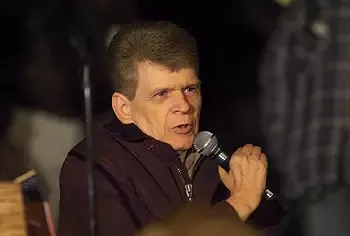HeroVet: Tom Corey, Veterans Activist

The day he was hit, Tom Corey had a premonition. It was January 31, 1968, the second day of what soon became known as the Tet Offensive. The young 1st Cavalry trooper, a veteran of eight months in the bush, "had a really bad feeling. When we were told to saddle up, something just didn’t feel right. The other guys said, ‘Oh, don’t worry. You’ve been in firefights before.’ " But Corey was still uneasy.
They were just out of Dong Ha in Quang Tri province. They made an air assault into a hot landing zone when Corey’s platoon came under a barrage of fire. They scrambled for cover behind a rice paddy dyke. The crack crack crack of small-arms fire suffused the air. Artillery shells whined and exploded, creating instant ponds.
In the din of battle, Corey, a squad leader, a sergeant, needed to know where the other squads were positioned, and the path of assault his people would have to take. He peered over the top of the dike. He saw a flash from the tree line.
The flash was the discharge of the round that caught him in the neck, the round from an AK-47 that severed his jugular vein and main artery, hit his spinal cord, and forever changed his world.
"I remember what felt like someone trying to give me mouth-to-mouth. I said, ‘God forgive me.’" That was the last thing Corey remembered "for days and days."
But Tom Corey’s war was far from over.
Prelude to Battle
The second oldest of ten kids of a city worker in Detroit, as a teenager Corey was fascinated with cars and racing and girls. He raced along the streets of the Motor City, spent a lot of time at drag strips. He built a race car in high school. Yet he did not like school and saw no college education, and a lot of question marks, in his future.
Then the Army intervened. Fighting was heating up against Communist guerrillas in a place called Vietnam, and the military needed bodies. Like many of his friends, he "didn’t even know where Vietnam was. None of us paid any attention to geography or politics."
On December 7, 1966 – Pearl Harbor Day – Thomas H. Corey was drafted. He would soon come to learn that Vietnam was a war as well as a place.
The Army gave his life direction of sorts: To Fort Knox, Kentucky, for basic training. To Fort Polk – "Fort Puke" – Louisiana, for advanced individual (infantry) training. Then, after he got married, halfway around the world to this place called Vietnam to hone his newly acquired skills in combat.
Corey was assigned to the 1st Cavalry (Airmobile) Division. At the Cav’s base camp at An Khe in the Central Highlands, he was given his ration of gear, shot a few rounds with his M-16, and was sent out to the field. Except for brief periods at base camp to regroup, he would remain in the field, in the boonies, for his entire, truncated tour of duty.
"First day in the field, guys just back from a firefight told me, ‘You do any drugs, we’ll kill you. You don’t need a screwed up head if you want to survive.‘ Don’t worry about me and drugs, I replied." A few hours later, Corey and three or four other newbies headed out to their first firefight.
"One of the guys who had been there a while told me, ‘Stay with me. Just keep your head down and we’ll get through this.’" They did. And while the clamor and losses of war were always difficult, "each day it seemed to get a little easier to prepare for battle," Corey said, as he learned the dos and don’ts, the blacks and whites, of fighting an unconventional enemy in a war without a front.
It wasn’t long before the reality of this war became apparent to the young troop and his mates. "We’d go into battle, seize a village, then give it up and return three months later to take it again."
When they could, they’d choose their encounters. "We’d walk around at night looking for trouble, and when we found it we dealt with it. But a lot of times," Corey said, "we had to let it go by."
Beyond the nightly ambushes and search-and-destroy forays, Corey’s unit, Company C, 1st Brigade, 12th Cavalry, fought in some "pretty major battles that lasted for days." On December 15, 1967, his company was almost overrun. "A couple of us got cut off from the rest of the platoon. After several hours," he said, "we were running out of ammo. I had one grenade left. I thought: ‘This is gonna be it. I’m going to go down with my last magazine.’"
Armored Personnel Carriers – tracks – came to the rescue, like the cavalry in the western movies that were a staple of youngsters growing up in the 1950s. Corey and his friend Wayne Ryza got behind one of the APCs just before it was disabled, hit dead on by a rocket. With bullets whizzing everywhere, Corey and Ryza were extricating the wounded when a second round hit. Corey was blown back. Ryza, his best friend, who had been inside the track, was killed. The battle raged on. There was little time for mourning.
Thomas Corey would receive the Bronze Star with V device for his actions in that encounter.
Brave New World
When Tom Corey first opened his eyes, he thought he was in a hospital. Then he was in the clouds somewhere, in a drugged haze of dream and reality, slipping in and out of consciousness. He was flown to Japan, where he spent several days before he was shipped to another hospital on his way back to "The World." It was there that 23-year-old Tom Corey was told he was paralyzed, that he’d live his life as a quadriplegic, without the use of his arms or legs.
He was transported to Fitzsimmons Army Medical Center in Colorado, then to the VA’s spinal cord injury center in Memphis, the closest specialized facility to his home that wasn’t filled with desperately wounded young men. He was en route to Memphis the day Dr. Martin Luther King, Jr., was shot.
In the last month of that terrible year, the bloodiest year of the war, after a series of operations and physical rehabilitation, Tom Corey decided, "I’m outta here." The hospital was a mess, overcrowded with the human detritus of war, men whose lives were shattered, and "couldn’t give me any of the therapy I needed," Corey said.
Although he wasn’t as angry then as when he first arrived in Colorado and learned more about the disability he would live with for the rest of his life, he was "frustrated and angry as hell to be dependent on someone else to do then just about everything for me," he said.
It was this loss of independence that rankled more than anything.
Tom Corey returned to Detroit, to the welcoming embrace of his family. He was fortunate, he said, "to have come from a big family, and to have married the woman" that he did. It was then that he started to become aware of the politics and policies of the war that had robbed him of his mobility.
"At first I didn’t question the war, even though I didn’t agree with how we were going about fighting it," he said during an interview at the national headquarters of Vietnam Veterans of America in Silver Spring, Maryland. "The war protesters angered me a lot at first: I still had friends over there who were trying to do their job and survive," he said. It was only later that he came to understand and accept that those who served and demonstrated against the war did so because they felt it was necessary that they make a statement about what they saw as the insanity of this war – and to save lives.
In 1972, Corey moved to West Palm Beach, Florida, where he spent a lot of time in hospitals. At the JFK Medical Center, "a doc on the surgical medical team who treated me in Danang remembered me. ‘We never thought you would survive,’ he said. ‘We did the best we could but after that, [the outcome] was not up to us, it was up to God.’"
A New Awareness
It was at the Miami VA hospital that Tom Corey’s political education flowered, and he soon became active in fighting another war, this time in the arena of veterans issues.
The new battle he was fighting then – and is fighting now – he felt strongly about. "I wanted to recognize and honor guys I’d served with who had been killed. I wanted to do something to make sure they – and the guys who survived – were not forgotten."
He plunged into the ranks of the newly emergent veteran activists. He became active with Paralyzed Veterans of America in the mid-70s and joined VVA in 1980. A year later, he was the founding president of VVA Palm Beach County Chapter 25 (which was renamed the Thomas H. Corey chapter at its tenth-anniversary celebration). He also is a member of the Military Order of the Purple Heart Association, Disabled American Veterans, the American Legion, Veterans of Foreign Wars, the 1st Cavalry Association, the National Association of Uniformed Services.
For Tom Corey, his activism is personal. "We helped paraplegics and other quads, guys who were screwed up. We fought for the establishment of a Vet Center in West Palm Beach. We worked with a lot of Montagnards as well as Vietnamese to gain them their freedom as they fled Communism."
Often he found himself on the front page of his local daily. When his son Brian was born in 1982, reporters were waiting in the lobby of the hospital to interview him on some local veterans issue.
With notoriety and exposure, Corey’s privacy decreased. "Vets would call in the middle of the night. ‘I need help; I need help.’ Some were suicidal. My wife would get me up and I’d go and meet with them. Sometimes I’d just talk with them; sometimes I’d have to convince them to surrender their weapon" to keep them from hurting themselves or others.
"We fought for what was right, and for what was important for those who served, for those who didn’t return, for those who are still suffering today."
Bridging the Gaps
Tom Corey’s activism was recognized by his brother and sister veterans. He was the first recipient of the Vietnam Veterans of America’s Commendation Medal, VVA’s highest award for service to veterans, their families, and the community. In 1985, he was elected to VVA’s National Board of Directors. Two years later, he was elected VVA National Secretary, a post to which he was re-elected four times. In 1997, he was elected VVA National Vice President. In 2001, he was elected National President.
Now in his second term as VVA President, his focus is to "try to make sure those who served – and those who are serving today – are taken care of for what they have given to our country," he said.
He has made 14 trips back to Vietnam to meet with our former enemy, to seek a common ground in searching for the remains of Americans and Vietnamese who perished during the war, to discuss issues of mutual importance, like the effects of the thousands of tons of Agent Orange and other herbicides that America sprayed over much of Vietnam. Just as important, he makes these trips – they are, he said, "killer trips" that are physically punishing – to break down the barriers that prevent mutual understanding.
The trips, he said, "are so important, so necessary if we are to achieve the fullest possible accounting of our missing and learn more about the long-term effects of Agent Orange.
"We’ve earned respect from the Vietnamese for returning with information we promised, information we’ve received from American veterans," he said, which will only help in the search for healing and for closure.
On one of these trips, in 1997, he met an orphaned 10-year-old Vietnamese girl named Trang. Two years later, she came over to visit for a summer and didn’t go back: Tom Corey adopted her when she was 16.
His activism is fueled in part by anger. He is outraged by the outright lies told by government agencies, by our leaders during the Vietnam War – and during the current war. "It seems that they don’t want to take responsibility for the actions they’ve committed the country – and young men and women – to take."
His mantra: Although it’s unfortunate, don’t trust your government. Be skeptical. Yet at the same time, acknowledge the sacrifices of those who have done the nation’s bidding, who have given something very precious for our country – their blood and their tears.
For Tom Corey, the battle still rages.
Image Credit: http://www.vietnamproject.ttu.edu/inmemory/in_memory/dedication/album.htm


